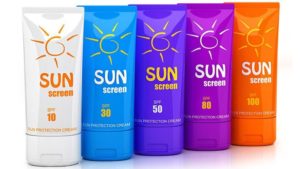 From the American Academy of Dermatology (AAD)
From the American Academy of Dermatology (AAD)
Do you find the alphabet soup of terms on sunscreen confusing? If you answered yes, you’re in good company. A study published in JAMA Dermatology says that fewer than half of the patients at a dermatology clinic knew the meaning of terms like “broad spectrum” and “SPF.”
Some of these terms, such as “broad spectrum” and “SPF,” have very specific meanings because they come from standards created by the U.S. Food and Drug Administration (FDA) for testing sunscreen. Others lack this official meaning, but you’ll frequently see them on sunscreen.
Being able to decipher these terms can help you choose a sunscreen that gives you the protection you expect.
You’ll find everything you need to decode a sunscreen label below.
What is broad spectrum sunscreen?
FDA meaning:The sunscreen can protect you from the sun’s harmful ultraviolet A (UVA) and ultraviolet B (UVB) rays.
Why you want broad spectrum sunscreen:
It can protect your skin from the sun’s UVA (aging) rays and UVB (burning) rays, which helps prevent:
- Skin cancer
- Early skin aging (premature age spots, wrinkles, and sagging skin)
- Sunburn
What is SPF?
FDA meaning: How well a sunscreen protects you from sunburn.
To simplify things, you may want to think of the sun protection factor (SPF) as the “sunburn protection factor.”
About SPF numbers:
Another confusing thing about SPF is the number that follows it. This number tells you how much UVB light (the burning rays) a sunscreen can filter out.
Here’s what the science tells us about how much UVB light different SPF’s can filter out:
- SPF 15: 93% of the sun’s UVB rays
- SPF 30: 97% of the sun’s UVB rays
It’s important to know that no sunscreen can filter out 100% of the sun’s UVB rays. That’s why it’s important to also wear protective clothing and seek shade.The AAD recommends using an SPF 30 or higher.
What is waterproof sunscreen?
There’s actually no such thing as waterproof sunscreen. Sweat and water wash sunscreen from our skin, so the FDA no longer allows manufacturers to claim that a sunscreen is waterproof. Some sunscreens are water resistant.
What is water resistant sunscreen?
FDA meaning: How long (either 40 or 80 minutes) the sunscreen will stay on wet skin. The sunscreen must undergo testing before it earns the water resistant designation.
Water resistant:
The sunscreen stays effective for 40 minutes in the water. At that time, you’ll need to reapply.
Very water resistant:
The sunscreen stays effective for 80 minutes in the water. Yes, after 80 minutes, you’ll need to reapply.Even if your skin remains dry while using a water resistant sunscreen, you’ll need to reapply the sunscreen every 2 hours.
Why reapply sunscreen?
Once applied, sunscreen only lasts so long on our skin. The sun’s rays break down some sunscreens. Others clump and lose their effectiveness.
To continue protecting our skin from the sun when outdoors, we must reapply sunscreen:
- Every 2 hours
- After toweling off
- When sweating*
- After being in water*
*When using water resistant sunscreen, you’ll need to reapply every 40 to 80 minutes.
What’s the difference between a chemical sunscreen and physical sunscreen?
Each of these protects your skin differently and contains different active ingredients. Here’s a summary of the basic differences:
A chemical sunscreen:
- Protects you by absorbing the sun’s rays
- May contain one or more of many possible active ingredients, including oxybenzone or avobenzene
A physical sunscreen:
- Protects you by deflecting the sun’s rays
- Contains the active ingredients titanium dioxide and/or zinc oxide
Some sunscreens use both types of active ingredients, so they contain one or more active ingredient found in physical sunscreen and chemical sunscreen.
What does the word “sports” mean on sunscreen?
The FDA has NOT defined this term for sunscreen.
When you see the word “sports” on sunscreen, it usually means that the sunscreen will stay on wet skin for either 40 or 80 minutes. To be sure, check the label. You may also see the words “water resistant” or “very water resistant.”
To protect your skin, you’ll need to reapply sports sunscreen:
- When sweating (every 40 or 80 minutes)
- After toweling off
- After getting out of the water (or every 40 or 80 minutes)
- Every 2 hours (when not sweating or in the water)
What does the word “baby” mean on sunscreen?
Like the word “sports,” the FDA has not defined this term for sunscreen.
In general, when you see the term “baby” on sunscreen, it means the sunscreen contains only these active ingredients:
- Titanium dioxide
- Zinc oxide
These ingredients are less likely to irritate a baby’s sensitive skin.
The AAD recommends the following when using sunscreen on babies and toddlers.
Children younger than 6 months of age:
- Protect their skin from the sun by keeping them in the shade and dressing them in long-sleeved shirts, pants, wide-brimmed hats, and sunglasses. Take care, of course, to prevent overheating.
- If possible, avoid using sunscreen on these children.
Children 6 months of age and older:
- Use a sunscreen that contains zinc oxide or titanium dioxide, which is most appropriate for the sensitive skin of infants and toddlers.
- Even when using sunscreen, keep children in the shade and dress them in clothing that will protect their skin from the sun, i.e., long-sleeved shirts, pants, and wide-brimmed hats.
What does the term “sensitive skin” mean on sunscreen?
Again, the FDA does not define this term for sunscreen.
In general, if a sunscreen label says “sensitive skin,” it often means that the sunscreen:
- Contains one or both of these active ingredients — titanium dioxide and zinc oxide
- Does NOT contain fragrance, oils, PABA, or active ingredients found in chemical sunscreens, which can irritate sensitive skin
- Is hypoallergenic
Is it best to use sunscreen that contains insect repellant?
If a sunscreen label says it contains insect repellant, the Academy recommends looking for another sunscreen.
While both products provide important protection, the Academy recommends buying separate products because:
- Sunscreen should be applied liberally and often
- Insect repellant should be applied sparingly and less often than sunscreen







